Places Visited:
Montana: Visiting Headwaters of the Missouri
Park near Three Forks Montana.
July 30, 2007.
We are staying in Cameron
RV-Park & Store in Cameron, Montana. Cameron is a STORE located 10-miles south
of Ennis in the Madison Valley. The Cameron RV-Park is about 12 sites located
behind the Store & Saloon (the social gathering place for miles around). The
PPA campground is nothing fancy but for the PPA price of $12.50 for FHU it is
just fine. The view over the Madison Valley and mountains surrounding Virginia
City is worth the $12.50.
Today we are traveling in our motorhome from Helena,
Montana to Ennis, Montana and have stopped at Wheat Montana a well known business
that specializes in wheat products from flour to bakery goods. We dropped the
motorhome in their parking lot while we drove our "little red Saturn"
to visit Headwaters of the Missouri State Park near Three Forks, Montana. We dropped
the motorhome at exit 274 on I-90 then drove the Saturn east to exit 278 where
we exited onto the road that took us into Headwaters of the Missouri State Park.
I
suppose about this time you are asking "What is the attraction with Headwaters
of the Missouri" --- and that would be a good question. The best I can tell
you is that the spot is historically important since it is the headwaters of North
Americas longest river. It is also historically important because Lewis (of Lewis
& Clark fame) was charged by President Jefferson to locate the headwaters
of the Missouri River. You can also say that it was a significant place for anyone
that has read journals about the Lewis and Clark expedition. I suppose that we
are stopping here to check off another place mentioned in Lewis and Clarks account
of their epic journey.
I think Thomas Jefferson's instructions to Meriwether
Lewis on July 4, 1803 was: "The object of your mission is to explore the
Missouri River, and such principal stream of it, as, by it's course & communication
with the waters of the Pacific ocean...may offer the most direct & practicable
water communication across this continent..."
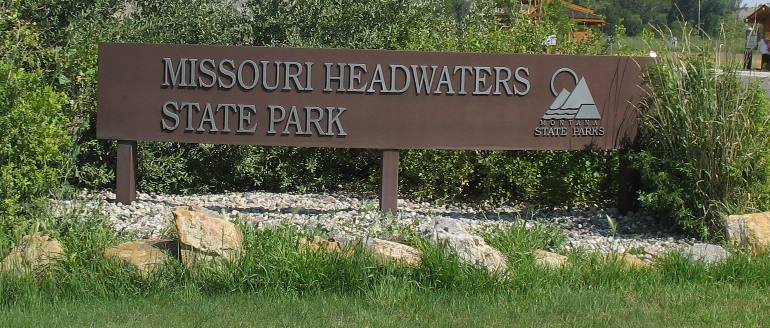
Here
we are.
This is where three great rivers
join together forming the Missouri River, waterway to the nation's heartland.
This headwaters region has lured people for thousands of years. Native people,
trappers, explorers like Lewis and Clark, Mountain Men like John Colter, miners,
homesteaders and speculators have all passed this way.
The three rivers
that join at this spot are the Madison, Jefferson and Gallatin Rivers forming
the Missouri River thus the name Headwaters of the Missouri.
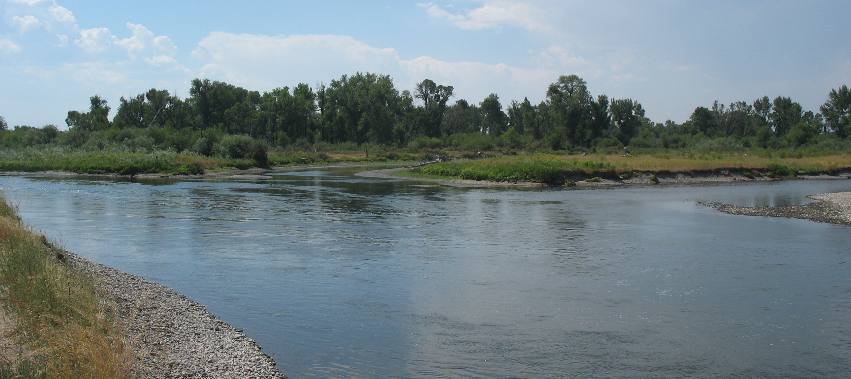
This
is where two of the river join. To the left is the Madison River while the river
entering from the right is the Jefferson.
Of course the Jefferson River
is named for President Thomas Jefferson while the Madison River is named for James
Madison who at the time was Secretary of State (I think) and later became President.
Wasn't it Madison that negotiated the Louisiana Purchase?
Native
Americans have a long tradition at the Headwaters, considered by many to be a
sacred place. Many different tribes came here to camp, hunt, fish and gather plants
along the river banks.
In 1805, Lewis and Clark passed through this area
following President Thomas Jefferson's orders to search for a Northwest water
passage he believed might cross the continent. Lewis and Clark and their men camped
here for three days.
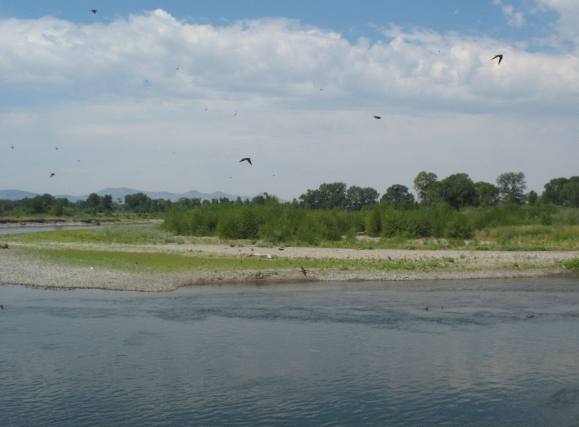
This
region was alive with beaver, otter and game before the white men came it was
disputed hunting territory with the Indian tribes. Sacajawea, the Shoshone squaw
who helped guide portions of the Lewis and Clark Expedition, was captured near
here when a child during a battle between her people and and another tribe. Her
memories of this country were invaluable to the explorers. The Expedition, westward
bound encamped near here for a few days in the latter part of July 1805. The following
year Captain Clark and a party of his men came back, July 13, 1806, on their way
to explore the Yellowstone River.
This is the Confluence of the Jefferson
and Madison Rivers that results in the Missouri River. While I took this picture
at the confluence of these rivers I was trying to get a picture of the huge flock
of bank swallows flying over the river. They were nesting in the bank on this
side of the river. The bank was about 10' feet and steep with absolutely no way
to get to the water and walk along the bank. That is why the bank offered them
a safe nesting place.
In any event we are standing on the eastern bank
with the camera pointed to the west. That is the Jefferson River you can see in
the distance on the left side of the picture. The Madison River is flowing from
the south which is to the left.
But to me the best
story emanating from this area is that of John Colter. If you remember John Colter
was the "Mountain Man" credited with discovering Yellowstone Park. He
was also a former member of the Lewis and Clark Expedition. John Colter was released
from service by Lewis and Clark on the Expeditions return trip in 1806 sometime
before they arrived back in St Louis. John wanted to return up the Missouri River
with a group of trappers. Lewis and Clark released John on the condition that
no other members of the expedition would be allowed to leave until the mission
was complete. John Colter became a noted Mountain Man and explorer after his release
from the Louis and Clark Expedition in 1806.
In 1808 John Colter was trapping
on a stream in the vicinity of the Headwaters of the Missouri when he was captured
by a band of Blackfeet. His only companion was killed. Colter was stripped naked,
given a head start, and ordered to run across the flat which was covered with
prickly pear. The Indians were hot on his heels but Colter undoubtedly made an
all time record that day for sprints as well as distance events. He outran the
Indians over a six-mile course and gained the cover of timber along the Jefferson
River. Once in the stream he dove and came up under a jam of driftwood. This hide-out
saved him from a lot of disappointed and mystified Indians. When night came he
headed east, weaponless and outnuding the nudist. He traveled in this condition
for seven days to Fort Lisa, his headquarters, at the mouth of the Big Horn River.
Like
I said, that story about John Colter, the noted Mountain Man, is one for the record
books.
Sacagawea was a child when she was kidnapped near here and it was
several years later when she was probably 17 years old, with an infant, that she
came back through here with the Lewis and Clark Expedition.
In the years
during the Civil War , ( circa 1863) a few entrepreneurs started a small town
here that survived only a few years. These entrepreneurs had dreamed of becoming
a major transportation center, with steamships connecting to stage lines. I do
not know why they thought steam boats could operate up this far on the river knowing
about the Great Falls of the Missouri that Lewis and Clark had written about.
Steam boats don't climb water falls.
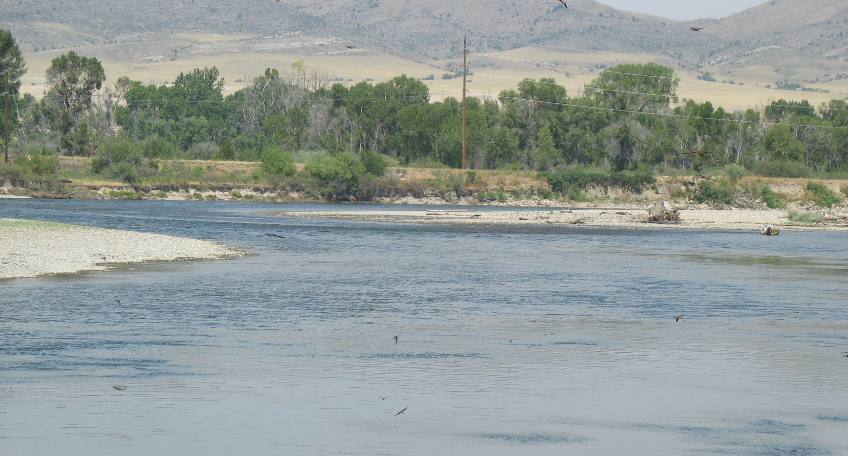
This
is another picture of the confluence of the Madison and Jefferson Rivers. This
time I am facing more or less south. The Madison River is flowing from the left
while the Jefferson River is flowing from the right. The river in the foreground
is the Missouri that was created at the confluence.
The Madison River
flows out of Yellowstone National Park. The Jefferson River has its headwaters
near Twin Bridges, Montana some 100-miles to the southwest.
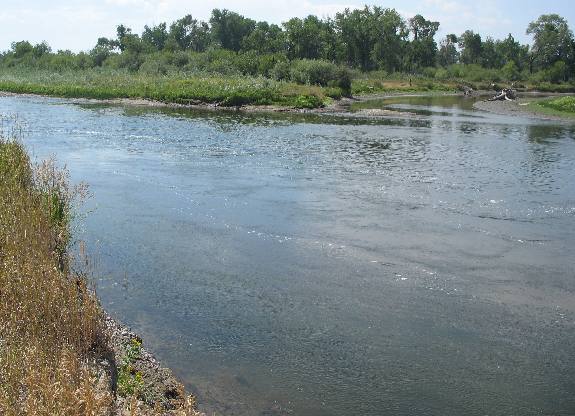
This
is another picture of the Madison River before it meets with the Jefferson. As
you can see the Madison River has a significant volume. The Madison River's headwaters
are in Yellowstone National Park.
For those of you who are familiar with
Yellowstone National Park the Headwaters of the Madison River are located at Madison
Junction where the road to West Yellowstone intersects with Grand Loop Road. It
is the Gibbon River that flows under the bridge just south of the Madison Junction
(even though the sign on the bridge identifies the river as the Madison). The
Gibbon River and the Fire Hole river meet to form the Madison River a few hundred
yards west of that bridge. The confluence of the Gibbon River and Firehole River
takes place in the Madison Campground area located on the southwest corner of
Madison Junction. The Fire Hole River flows in from the south and the Gibbon River
flows in from the north.
The confluence of the Fire Hole and Gibbon Rivers
form the Madison River.
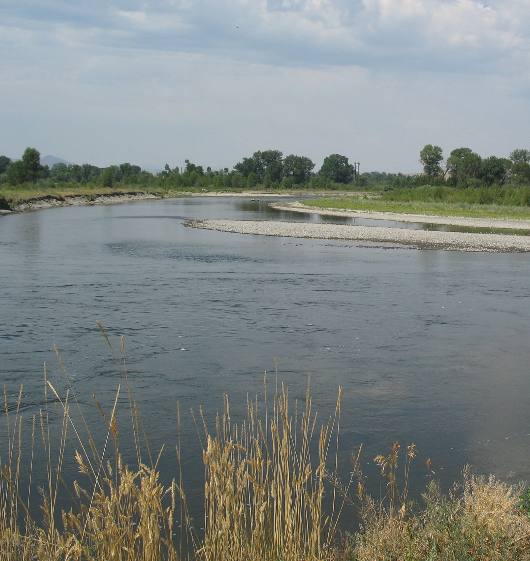
This
is the Jefferson river as it merges with the Madison River. The Madison River
has double the volume of the Jefferson, in my opinion. The Missouri River begins
at this spot.
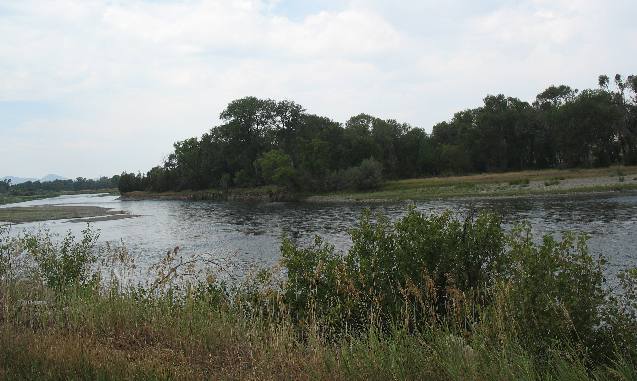
This
is another look at the Madison River prior to merging with the Jefferson River
forming the Missouri River about a mile downstream.
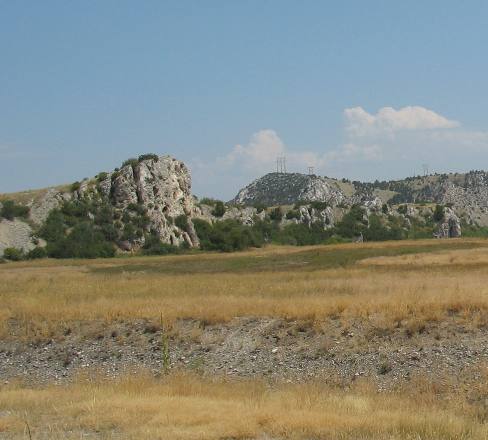
Lewis
climbed on this limestone cliff to survey the surrounding area. He described this
rock but I don't have my Lewis and Clark books handy and the Park didn't have
a kiosk that provided that information.
After
the fur trade died down gold was discovered in Montana. The first wave of white
settlers flocked to this region. The early farming settlements in the Headwaters
area were started to supply the gold camps at Virginia City along Alder Gulch.
In
1863, Montana got its first ferry here at the Headwaters. It mostly carried wagons
and stages across the river for people traveling to Helena, the gold camps, or
the Gallatin Valley. Each person paid 25-cents to cross. Don't let that 1863 date
of the first ferry in Montana slip by without recognizing that it was during the
Civil War.
It was at this spot that after a grueling trip up the Missouri
River, the Lewis and Clark expedition reached the Headwaters of the Missouri River
in July of 1805, fulfilling one of the main directives from President Thomas Jefferson.
They became the first non-Indians to explore this area, at least they are the
first to document that they visited this area.
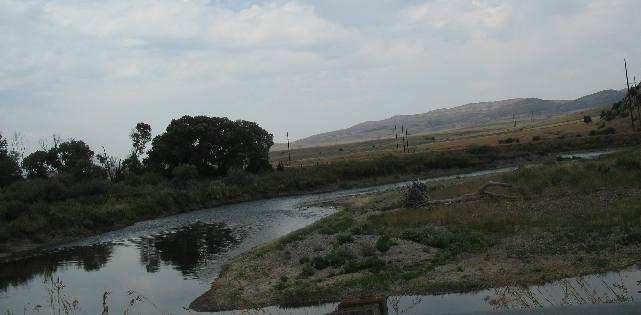 This
is the Gallatin River the third and final river to meet at this spot. It actually
joins the Missouri River several hundred yards north of the confluence of the
Madison and Jefferson Rivers. You can't actually see the confluence of the Gallatin
River and Missouri River in this picture. We both wanted to walk to the spot but
it was nearly 100 degrees outside and was just too hot. We both walked to the
confluence of the Madison and Jefferson Rivers and have not yet recovered from
that walk. The heat is brutal. The area is locked in a record breaking heat wave.
The actual confluence is less than 100 feet from where this picture stops. Close
but no cigar.
This
is the Gallatin River the third and final river to meet at this spot. It actually
joins the Missouri River several hundred yards north of the confluence of the
Madison and Jefferson Rivers. You can't actually see the confluence of the Gallatin
River and Missouri River in this picture. We both wanted to walk to the spot but
it was nearly 100 degrees outside and was just too hot. We both walked to the
confluence of the Madison and Jefferson Rivers and have not yet recovered from
that walk. The heat is brutal. The area is locked in a record breaking heat wave.
The actual confluence is less than 100 feet from where this picture stops. Close
but no cigar.
The Gallatin River has its headwaters in Yellowstone
National Park a few miles north of Madison Junction.
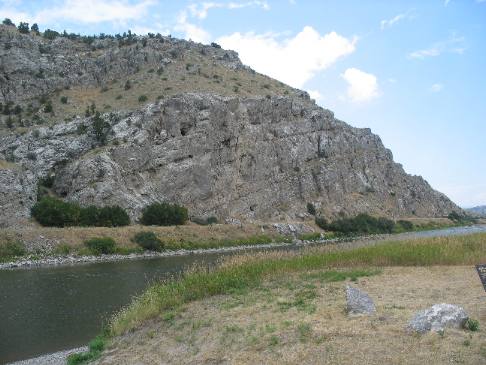
This
magnificent limestone cliff is on the newly formed Missouri River a few hundred
yards downstream from the confluence of the Gallatin River. The Missouri River
is flowing north at this point and will continue in a northerly direction for
around 100 miles before turning to the northeast and finally east, near the Canadian
Border. It will flow east across the top of Montana and part of North Dakota before
turning south into South Dakota.
Upon
leaving Headwaters of the Missouri State Park we headed in to the city of Three
Forks. It was only about 3-miles into the city.
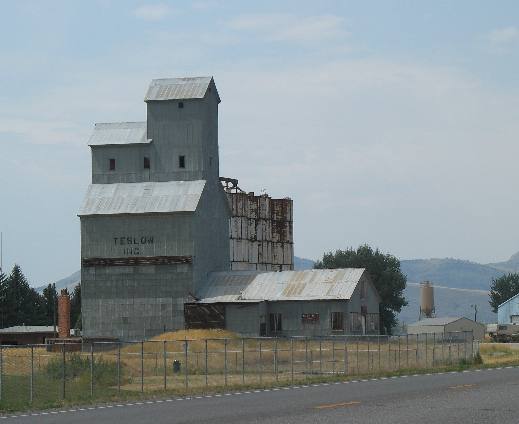
On
the way into Three Forks we passed this old grain elevator. There seems to be
a good number of these old grain elevators still in existence. I wonder if this
one is still in operation. We did not see any activity around the building so
I would guess not.
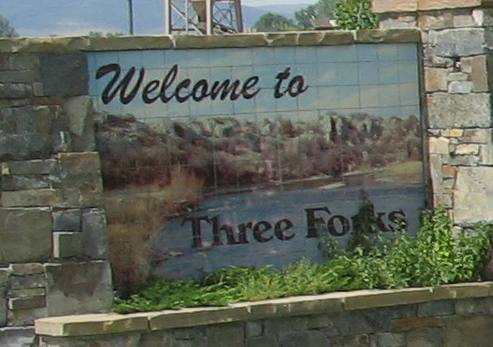
Three
Forks has several restaurants and a museum but we didn't stop. It is hot and we
want to get back to the motorhome and continue our journey to Ennis.
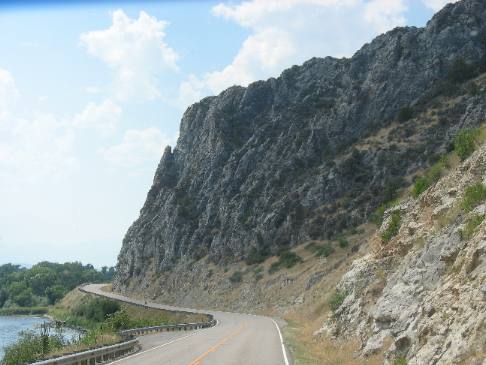
As
we continued south on US-287 from exit 274 on I-90 the highway followed the Jefferson
River for a few miles. The road during this section was notably scenic as the
narrow highway threaded its way between the sheer cliffs and the river.
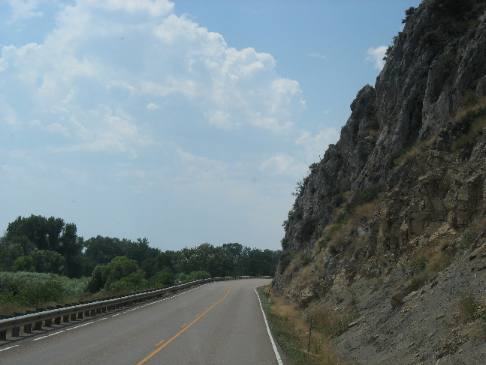
And
one last look at the cliffs carved by the Jefferson River as it makes its way
down to Headwaters State Park.
Until
next time remember how good life is.
Mike & Joyce Hendrix